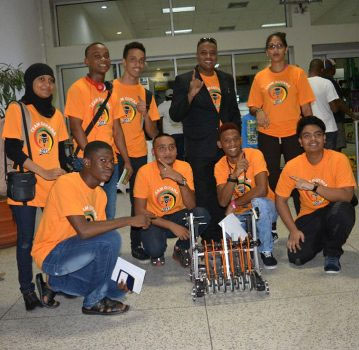Picture this: a classroom of students working collaboratively on a challenging science- or maths-based problem with an open-ended solution. They are exchanging ideas and learning from each other, are self-motivated and are even seeking out additional resources to help improve their knowledge. In fact, the students are so engaged that they protest when recess arrives and they’re told to pack up!
Classrooms such as these do exist, and are a refreshing and delightful experience for the weary educator. At St Paul’s Anglican Grammar School in Warragul, the use of robotics as a medium for teaching and developing a range of concepts has proven wonderfully successful, and has helped hand over the process of learning to the students themselves.
Robotics lends itself to project-based tasks: applied, real-life problems where there’s a goal to be achieved. Usually it is not so much about learning about the nuts and bolts of robots themselves, but about using robotics to highlight and explain concepts in maths, science and technology. Students can apply even basic robotics knowledge in order to learn by design, trial and experience, which is one of the most immediate and effective sequences possible.

A traditional educator might walk into a class and announce: ‘Today we’re going to learn to calculate gear ratios’. You can just about hear students’ brains shutting down. By comparison, robotics can be used to teach the same outcome by ‘stealth’, as students design basic robots for a hill climb challenge, for example, or a snail race: both are excellent for learning about gears. For the hill climb, students are challenged to get their robots to climb as far as possible up a J-shaped ramp, with points awarded for each marked line crossed. Initially many groups – typically the boys – will build dragster-looking vehicles designed for high speeds. But when the ‘demo or die!’ exercise shows that the high-speed vehicles are miserable achievers when compared to their smaller, more humble-looking counterparts, the students will inevitably be asking themselves ‘Why?’ And isn’t this the cue for great learning?
As the successes and not-so-goods are dissected, students get to examine concepts such as motor output, power consumption, amps vs volts, gearing (now the kids will want to hear about ratios!), traction, weight distribution, and so forth. If a second opportunity is allowed, groups will nearly always want to improve, so they will ask each other what they did to get so far – an example of spontaneous peer tutoring in action. Inevitably they will use the internet or other resources to start to look at successes in the real world, and apply some of what they find to their experiments. In this way, they have just started to learn for themselves – they have broken free of the teacher’s umbilical cord and are following directions of their own choosing.
This sort of self-directed, challenge-based learning means that there has been a shift from simply absorbing and regurgitating facts to the application of knowledge and learning by experience. There are no winners or losers in this type of learning: all groups have the opportunity to improve their designs and knowledge, and students will come to appreciate there is no single ‘right’ solution. For example, if the teacher in the learning scenario above wanted to focus learning on just the gearing and ratios, they could choose a ‘snail race’ challenge, in which groups are challenged to make their robots – with their motors set to full speed – travel as short a distance as possible in five minutes. (The current record at St Paul’s is about 8 centimetres.) This type of challenge really gets students thinking about how to arrange clusters of gears.
Many traditional topics too can be taught by ‘stealth’ using robotics. Light and reflection can be covered by programming line-following robots, or with ‘table-top dancers’, robots that move around a table without falling off the edge. Students can learn about the movement of a pendulum, or use data-logging tools to measure body temperature change while a student exercises. Human movement can be studied by examining the capabilities of a robotic arm, or by developing a walking robot. Data-logging tools and counters mean that reaction times, vehicle acceleration, and distances covered by a vehicle in a set amount of time can be recorded, graphed, or used for predictions.
Robotics can be used to generate group activities, and for problem-solving and logic-based activities. A great activity for younger students is ‘Burglar’, where each group sets their robot to record light readings, and then leaves the room. During this time, the teacher moves around the room shining a torch on each robot. The students will then use software to produce a graph of their light readings, and will work together as a class to find out in which order the ‘burglar’ moved around the room. An activity like this links learning about time, light intensity, direction, team work, technology, graph interpretation, and collaboration all in one!
The learner-centred approach of robotics education allows for open-ended teaching and learning outcomes – some schools have even made it possible for students to design parts of their own curriculum. For example, Brian Thomas of Bellarine Secondary College in Victoria has developed an excellent programme where students choose to complete a number of tasks from a selection designed to cater to individual interest and ability. For each completed task, students will receive a point score that reflects the task’s difficulty level. This means that students can work at their own pace: all they need do is achieve a nominated number of points to complete the unit.
So if the options are to stand at the front of the classroom and feed students more facts, or to assist in a dynamic, personalized, self-teaching environment that stimulates and rewards, it’s not exactly a tough decision! If you were a student, which would you choose?





